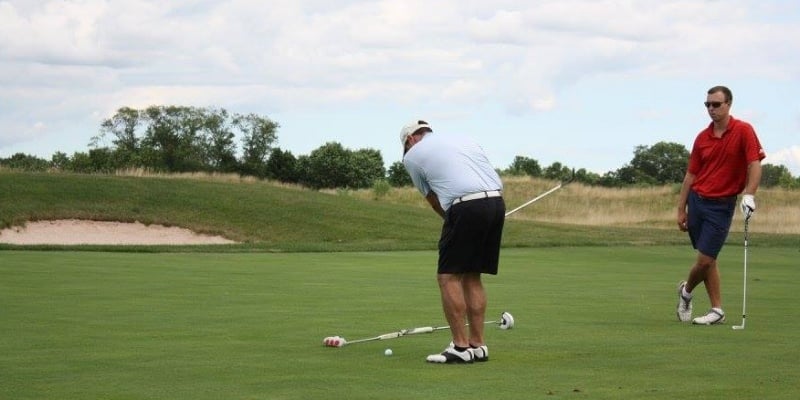All seriously competitive golfers must have the capacity to get up and down from difficult situations. Whether it’s short siding yourself in greenside rough or having to fly a trap off the fairway to a tight pin, the flop shot is a must have.
1) The Mission
Hit the ball high and land it soft (meaning minimal roll). In other words, you want landing the ball within a yard or two of the hole and having it stop.
2) The Lie
In order to hit the flop shot, there MUST be grass under the ball. The execution of the shot requires sliding the clubface under the ball, thus promoting backspin. The difficulty of the shot increases tremendously if you have a tight lie (no grass under the ball) as it is quite easy to blade the shot or hit it thin. The ideal lie for the flop shot is a fluffy one. You can hit a flop shot out of the thickest rough so long as you can get the face under the ball. If you can’t, then you must choose play a more conservative shot, even if that means leaving yourself a long putt. It's always better to take a 5 than a 6 or 7 caused by a bladed shot. The danger with fluffy lies, however, is sliding the club under the ball and essentially whiffing the shot. Here’s how to prevent it.
3) The Set Up
Select the highest lofted wedge in your bag. Much like a bunker shot, you set up with an open stance, a very open clubface, and the ball played forward of center. Where your weight is depends on the lie. From a tighter lie, you want your weight towards your front foot, allowing you to come in steep and get the clubface under the ball. From a fluffy lie, you need to center your weight so you don’t slide the face too far under the ball and miss it.
You want to promote that high flight with a soft landing. You’re hands should be slightly forward, creating a forward angle with the shaft. This causes your hands to lead, preventing you from getting too wristy on the follow through. Finally, you need soft hands. Gripping the club tightly will get rid of any backspin you would otherwise put on the ball – having soft hands is how you get the ball to stop.
4) The Shot
After setting up correctly, here are the keys to executing the shot.
- Wrist Hinge: On the way back, you must choose a point to hinge your wrists. Where that is depends on how far you need the ball to fly. This is where the FEEL part of the shot comes in. You DO NOT hinge your wrists right at take away – this will throw your timing off. On short shots, take a short swing with a quick wrist hinge. On longer shots, delay the wrist hinge in the backswing.
- Club Release: On the downswing, you ARE NOT simply flipping your wrists through the shot. You will lose control if you do this. Instead, release the clubface down through the ball and as pros say, "Let the club do the work." Don’t try to hit down on the shot to force spin as this can easily cause a mishit. You should also have a slight hip rotation through the shot, coming naturally from the movement of the swing.
- Finish High: This is one of the most important shots in golf to keep limit your unnecessary movement. Be deliberate in your motions, accelerate through the shot, and finish with the club high.
5) Upping the Difficulty
Not all the shots that call for a flop are going to be flat. With perhaps the exception of links courses, many of the greenside shots you will face will involve slope. There are, however, ways to compensate and hit the flop shot when it is called for even from these difficult angles.
The first thing you must do is match your shoulders to the angle of the slope which essentially makes it a flat lie as far as your body is concerned. This is particularly important on downhill lies. Then, swing with the slope. Since your feet, shoulders, and head are now in line with the slope, just swing normally. It’s important to note that shots from both downhill and uphill lies will not fly as far as flat lies, so you must compensate accordingly.
The flop shot is one of the most feel-based shots in golf – the only way to make it a reliable shot when you are on the course is to practice it. Use these steps to get it close from greenside.









